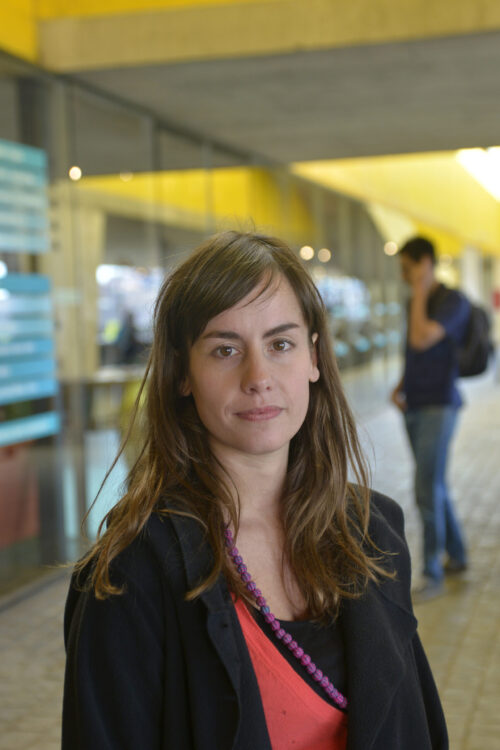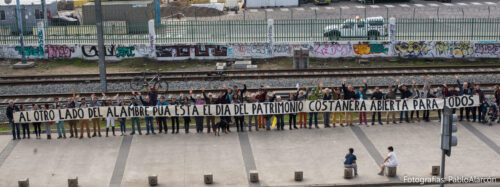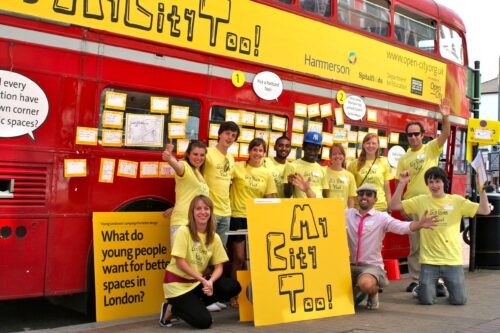
Magdalena Novoa, Assistant Professor of Urban and Regional Planning
Connecting People Through Art, Culture, and Heritage
By Rolf Pendall
Dr. Magdalena Novoa works on community development with the unique perspective of an artist who found a pathway into planning via cultural heritage studies and historic preservation. Having received her PhD in summer 2020 from The University of Texas at Austin, she joined the department’s faculty in August 2020.
From the gallery to the streets
“My path to urban planning wasn’t straightforward,” says Dr. Novoa, who grew up in Santiago, Chile. “I thought of myself since I was 10 as an artist, not as an architect or planner or urban designer, and I studied fine arts.” But while, and after, she was studying art, she engaged with the public spaces of her home city – marking her initial development as a practitioner and researcher in community development. “From my training as a painter, I started working as a street artist, critically analyzing and reworking commercial advertisements in the city of Santiago from a feminist point of view.” With “a mixture of collage and street art,” Magdalena reworked these advertisements on the walls in the street. “I got to know and walk in the city, in the night mostly.”

Magdalena Novoa, Assistant Professor of Urban and Regional Planning

Grassroots organization Pacto Urbano La Matriz de Valparaíso protesting during the Chilean National Heritage Day.
From the gallery to the streets
While studying and practicing art in Chile, Magdalena worked in a museum as coordinator of education programs. As she grew more confident in that role, she also became interested in ways to fuse her practice as a public artist with her skills as an educator. “More than understanding arts or engaging from a traditional environment like a museum,” she says, “I wanted to explore how the city could be a learning environment from an artistic point of view.” To deepen her understanding, she left Chile to pursue a master’s degree in arts administration in London. During that time she became involved with the Whitechapel Gallery, a renowned center for art exhibition and education. As she settled into a practicum as an arts educator in the nearby Tower Hamlets community, “everything clicked together.” While continuing her street art practices, she devoted most of her time to involving young people, most of them the children of immigrants from all over the world, in creative practices. She deepened this experience in her position at Open City foundation. Working as a coordinator of the My City Too program, Magdalena worked with young people, planners, and policymakers from different boroughs in London, developing participatory processes to involve youth in the decisions of their city.
“What I remember most [about this period of my life] is getting to know the city by myself,” she reflects. “I remember being open-eyed and open-minded about getting to know the city in an ethnographic way. That’s the method I use now; that was my real engagement and interest in urban planning. I’m grateful about that experience because it allowed me to understand the city in different ways, and what my role could be as an artist and facilitator to help solve problems in the city.”

Grassroots organization Pacto Urbano La Matriz de Valparaíso protesting during the Chilean National Heritage Day.

“Memorias de la Mujer Lotina” (Memories of the Lotina Woman). This 5.5 yd embroidery depicts the urban history of Lota from a female perspective using the local technique of “arpillera urbana.” Photo by Melissa Espinoza, January 2020.
Working within the State
Working within the State
After five years in London, Magdalena returned to Santiago, feeling that she could contribute more effectively to social change in her home country, especially having learned methods and perspectives that had not yet become common in Chile. “I went to work in the National Ministry of Culture, Arts, and Heritage, in the education department of the National Monuments Council,” a hybrid department that included research, education, and outreach.
Magdalena found this new post a paradoxically advantageous platform for advancing social equity. “In Chile,” she explains, “communities use heritage to challenge inequality and marginalization in the built environment, gentrification, and poverty.” Under the dictatorship of Gen. Augusto Pinochet that began in a bloody coup on September 11, 1973, Chile’s government enacted neoliberal laws and policies that subordinated the interests of working people and communities to the profit-making priorities of business owners. Many of these laws and policies remained on the books long after the return to electoral democracy in 1990.
Heritage conservation laws were never considered important enough to bother with, however, they provide communities with an opportunity to challenge property owners who might otherwise be able to displace them and gentrify their neighborhoods. As Prof. Novoa explains now, “It’s not an ideal law, but it does surpass property rights law, so people can use it as an instrument. Private owners can’t do things to the neighborhoods or property that are important to the community. I learned that by working with communities in the National Ministry of Culture.”
After working with the Ministry of Culture for four years, Magdalena had begun to see the limits of that position. It can be “frustrating to be part of the state,” she says, “especially in governments that are very politicized.” Changes in government brought the termination of projects and initiatives she considered important, leading her to the conclusion that in such a context, “as a public officer I couldn’t serve communities, but rather the objectives of a certain government.” This realization brought her to the next phase of her career: doctoral studies.

As part of her Ph.D. research, Dr. Novoa organized this participatory workshop with women in Lota that mapped the urban history of the city from a female perspective. Photo by Melissa Espinoza, January 2020.
Cultural heritage as an instrument of community development
Cultural heritage as an instrument of community development
Magdalena decided to pursue a Ph.D. at The University of Texas at Austin, home to one of the world’s preeminent interdisciplinary institutes of Latin American studies. Fernando Lara, a Brazilian Latin Americanist, directs the Graduate Program in Architectural History at UT, conducting research and practice on the dissemination of architecture and planning ideas in the Americas. Magdalena ultimately earned her Ph.D. in architecture, with a concentration on historic preservation, but she also engaged with faculty and students in the Graduate Program in Community and Regional Planning.
At UT, Prof. Novoa researched the construction of heritage through time. “Cultural heritage uses the past as a resource in the present to project for the future. That can have a very dark side, [as] when powerful groups use the past to establish principles or narrow the past historical view, to establish a social order. The official story erases the history of social organization, but we have other social traditions.” Cultural heritage can be a powerful resource for recalling valued counter-narratives, she says, that “can be an instrument of power and control for communities to imagine a different future.”
Her dissertation, Insurgent Heritage: Grassroots Movements and Citizenship in Chile, perfectly captures an example of such community-based heritage in Lota, an important mining and industrial enclave in central Chile for almost 150 years. After the mine that anchored the city’s economic base closed in 1997, the central government proposed economic rehabilitation plans, but these were both unsuccessful and unacceptable to many community members. Instead, these residents have relied on their cultural heritage to envision a sustainable alternative, recalling the violence of the mine owners but also the resilience of workers and women who developed and protected means of expression including theatre, art, and music.
Dr. Novoa’s dissertation shows that cultural heritage extends beyond historic preservation. “The US is the only part of the world that frames heritage as historic preservation,” she says. “For me, the logic of historic preservation is a technical approach to preserving and conserving buildings and the built environment. It doesn’t cover a broader sense of what heritage is for people, not only material aspects of the past, but very much about immaterial aspects and how both relate to each other.”
This perspective infuses her commitment as an educator, to show students how important cultural heritage is for all people’s lives. “We all have histories in our neighborhoods, traditional practices of families and neighbors, and that’s important to bring to urban planning. Arts and culture and heritage studies connect people,” which should make them central to planning for community development.
To further this work, while pursuing her Ph.D., Magdalena co-founded the non-profit organization Aldea, that develops practice and research in community development, participatory design, and historic preservation internationally. She also co-directs Open House Santiago (OH! Stgo), a city-wide annual event and community engagement platform aiming to promote the city as a learning environment for all by providing free access and appreciation of Santiago’s best architecture, public spaces, and urban design.

As part of her Ph.D. research, Dr. Novoa organized this participatory workshop with women in Lota that mapped the urban history of the city from a female perspective. Photo by Melissa Espinoza, January 2020.

My City Too members leading a Young Planners forum during the London Architecture festival 2010. Photo by Rafa Pavón, Open City foundation.
The future: A sustained role as change-making educator
The future: A sustained role as change-making educator
When asked her view of herself as an agent of change in society, Dr. Novoa responded on two levels. First, she hopes that her work uncovers and reinforces that “communities … are in fact [already] empowered,” and to build more “opportunities in the systems of power to give them space to take positions.”
“My vision of change is structural,” she says. “We talk about participation and community empowerment, but in the end, participation and inclusion [can be] an alibi for deepening policies that reinforce inequality and exclusion. The change I’d like to see is for communities to exert change and have opportunities to set the terms of participation and engagement,” rather than professionals and practitioners setting those terms. “I’d like to see a change in the structure that perpetuates racism and white supremacy in how cities are built.”
Prof. Novoa also hopes to contribute to how academia works, building on the tradition of community-engaged work that has been part of the Department of Urban and Regional Planning for decades. “As faculty, as researchers, we should be facilitators for our students to develop their careers, but also for communities to achieve change. On the one hand, I see myself as a facilitator of conversations between communities and planners, between decisionmakers, but also between other actors in society.”
“I’m interested in the positioning of DURP in the College of Fine and Applied Arts, because arts and artists have the opportunity to bridge the gap between expert and situated knowledge. Participation methods use dialogue, but we need other ways to see and communicate. The arts are a more adequate and global method for bridging. That also applies for education in the classroom as a learning environment, connecting the city as a learning environment to the classroom.”

My City Too members leading a Young Planners forum during the London Architecture festival 2010. Photo by Rafa Pavón, Open City foundation.